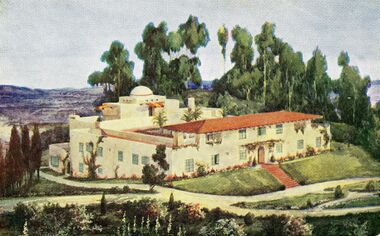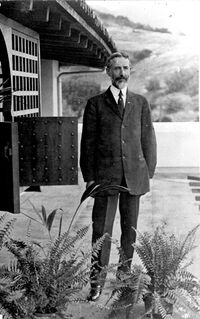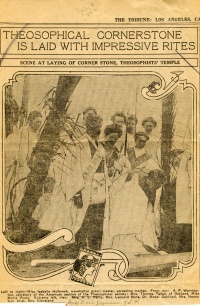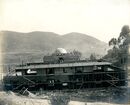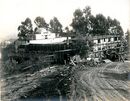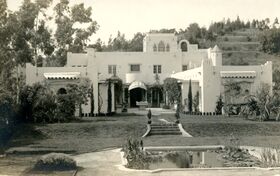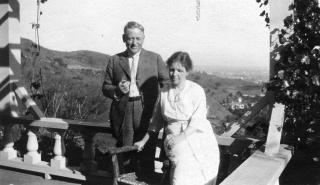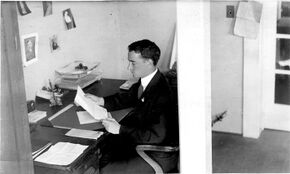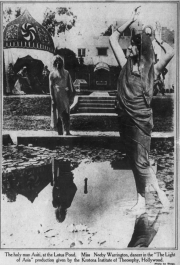Krotona in Hollywood
The Krotona colony of Theosophists was established in Hollywood, California in 1912 to be the national headquarters for the Esoteric Section, American Division. It also served for a time as headquarters for the American Theosophical Society and other organizations. It was succeeded in 1924 by the Krotona Institute of Theosophy based in Ojai, California.
The idea behind Krotona
During the early years of the 20th century, many people were exploring the concept of establishing a Theosophical colony. The success of Katherine Tingley's Point Loma was much in the news, and the Temple of the People had been established in Halcyon, California. Dr. Weller Van Hook, Adelia H. Taffinder, Mr. A. O Brandt, and Augustus Francis Knudsen had all suggested places for Theosophical centers. Utopian ideas were flowing throughout the world in the early 20th century; in 1922 The Manor became home to a Theosophical community in Sydney, Australia.
In 1906, Albert Powell Warrington sent Theosophical Society president Annie Besant a formal proposal for formation of such a community. It was called the "Prospectus of the Crotona Institute and the Fellowship of Crotona," and it laid out objectives to establish communal centers of industry and kindness; to establish schools to achieve "a balanced development of mind, body, and character;" and "to provide places of rest and restoration" [i.e., retreat centers].[1] The name Crotona, or Krotona, was derived from the school of Pythagoras. Mrs. Besant and her colleague Charles Webster Leadbeater were pleased with the proposal, appreciating the practical approach that Warrington took to establishing a community where everyday practices supported the inner life. Warrington "wrote that he nevertheless expected the more advanced students to form there a strong center for the practical radiation of universal love to all sentient beings, an active demonstration of the realization of the One Life."[2]
Annie Besant was the Outer Head, or international leader, of the Esoteric Section, also referred to as the E.S., and Warrington was corresponding secretary of the E.S., American Division. After Mrs. Besant gave her approval, Warrington proceeded with his proposal.
Selection of the site
Potential sites for the new community were considered in Virginia, Oklahoma, Texas, New Mexico, California, and Mexico, in a search process that took several years. Ultimately, the site for the colony was in Beachwood Canyon, a tract of land within Hollywood Hills developed by Albert H. Beach. In March, 1912, ten acres of the Hastings estate were purchased by the Krotona Organization Committee. A. F. Knudsen provided $5,000 toward the down payment of $12,000. The title to the property was initially in Warrington's name, but was transferred to the Krotona Institute of Theosophy, which was incorporated on March 12, 1913.[3]
Mr. Warrington, who became President of the American Theosophical Society in 1912, talked about the site selection process in a newspaper interview:
We chose this place because It is ideally situated. California furnishes an unsurpassed clime, and Los Angeles is the metropolis of a great melting pot from which is destined to emerge soon a new race; a people caused by the fusing of races now going on in this country. This will be the new American race, in whose hands will rest the solving of the problems now confronting the world.
That race will need wise guidance and great wisdom for the task: there must come a great world teacher and Theosophy will prepare the minds of men for his message. This teacher will not he a god. He will be a man; but with wisdom and insight to teach a new understanding of life...
Believing in the uplifting power of beauty, we shall make our buildings and grounds as beautiful as possible.[4]
In this message, Warrington referred to the Theosophical theories of Root-races and an anticipated new World Teacher.
Laying of the cornerstone
The cornerstone for the main building, the Krotona Court, was laid on July 2, 1912 in a Co-Masonic rite conducted by Isabelle Holbrook, Marie Poutz, A. F. Knudsen, and American Theosophical Society President A. P. Warrington. Local newspapers covered the event.
The procession which formed at the crown of the hill and wound its way to the bottom presented a picturesque appearance. The white robes of the co-masons, men and women alike, wearing the same regalia, with their stoics of red embroidered in gold, or Alcyone blue embossed with silver, their emblems of office held a loft, heads bowed, suggested a medieval procession...
Reaching the cornerstone, a square was formed, symbolizing the obligations of all human beings one to another, the righteous squaring of all action. Grand Marshal August Knudsen conducted the ceremonies at the command of the worshipful master. Miss Holbrook, and the stone was laid according to ancient custom not where it serves as ornament but beneath the surface. All the Masonic symbols were used. The stone was squared, leveled and plumbed and the work of the craftsmen found correct. On it was poured water [corrected to say wheat], the symbol of physical action, wine, the symbol of life and joy, oil, the symbol of peace, and salt, the symbol of fruitfulness.
The act, when completed, was proclaimed in touching and solemn manner by Grand Orator Eleanor Broenneman, and the triangular trowel, placed on the square by the worshipful master. The members were conducted under cover by the tyler, Dr. Mabel Caldwell. A. P. Warrington, head of American section, who founded Krotona, said the building is not to be for the seclusion of a sect but for the use of the people and for this reason the base of the hill was chosen in order that it would be accessible to the public...
The building, which is to be the first of a series, and is to be known as the administration building, will be 52 x 85 feet in dimensions, of concrete, three stories in height and contain twenty rooms. Among these will be an assembly hall, dining room, cafeteria, co-operative stores, business offices, small lecture rooms and study rooms. It is designed to make the grounds into a public park. [5]
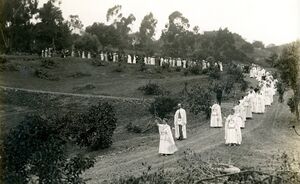 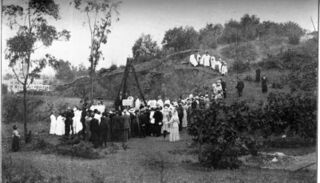
|
Mr. Warrington said:
We do not come to establish a sect with some limited form of truth, but to take the place of the inner temples of ancient times that held the esoteric side of great truths with key notes and interpretations of the hidden form of the wisdom that was given out in those days only to those who had proved worthy to be entrusted with its custody, but is now proclaimed to all. We seek no converts, for we have no creed to exalt, no church to build up; your creeds are our creeds, your churches our churches. The one religion that unites us all is the religion of Brotherhood, of universal tolerance.[6]
Charles T. Wood wrote an article on the beauty of the ceremony with a horoscope on the auspiciousness of the date.[7]
Construction and buildings
Buildings constructed at Krotona comprised "an interesting compound with Moorish, Pueblo, Spanish Colonial and other architectural styles melded in a picturesque melange."[8]
Funding for the buildings was based on donations and a mortgage that was quickly paid off. On July 26, 1915 at the annual convention of the American Theosophical Society in San Francisco, attendees celebrated completion of the final payment of the $7500 of the $12,500 mortgage on the Krotona property. At that point, the value of the 15 acres and buildings was valued at about $110,000.[9] Later another mortgage was obtained, mostly to finance operations.
Krotona Court
Krotona Court, also called Krotona Inn, was the centerpiece of the campus. It held a large lecture hall, with a kitchen and dining room underneath. There was an apartment on the second floor for Mr. Warrington, and a domed room for E.S. meetings. A lotus pool and lush plantings were in the courtyard. Sixteen rooms were available for guests.
The Temple of the Rosy Cross
Immediately next to Krotona court was the Temple of the Rosy Cross, built by the Order of the Temple of the Rosy Cross.
The Science Building
A small white rectangular building was built near Krotona Court to house science classes. It was donated and built by A. F. Knudsen.
The Ternary and adjacent land
In 1914, Henry Hotchener began offering to sell lots in a 15-acre property adjoining Krotona. Grace Duff Shaw, Hotchener, and his future wife Marie Russak built a complex of three houses called the Ternary, featuring an Italian-style garden and pool. Just below it on the hill was a small amphitheater used for theatrical productions. Hotchener offered to sell and manage acreage on behalf of "a syndicate of Theosophists" in a development to be called Templars Park.[10]
Other buildings
Early on, cottages were built for some of Krotona's workers; other workers set up tents on wooden platforms or rented rooms in Hollywood residences. The wealthier members like A. F. Knudsen built their own houses.
The people at Krotona
Workers at Krotona were mostly unpaid volunteers. The President of the American Theosophical Society, A. P. Warrington first arrived in California in 1910. Marie Poutz joined him by 1912 as his secretary and as assistant corresponding secretary of the E.S. She had been working with him since 1907 in the same roles in his Norfolk, Virginia law office. In 1913 she took over his role as corresponding secretary of the E.S., although he continued to head the organization.
L. W. Rogers and his young family had a house nearby at 2033 Argyle Avenue. He worked as the Propaganda Manager, and his wife May was editor of The Messenger, the Society's journal. Even after L.W. moved Society headquarters to Chicago in 1920, the family kept the Hollywood house as a base of operations, even into the 1940s. Their next-door neighbor was artist and Theosophist Beatrice Wood.
A. F. Knudsen donated a great deal of money to Krotona, and bought back rights to build a house on part of the property. Some of the other major donors who moved to Krotona were Eleanor Broenniman and Captain Russell Lloyd Jones. Max Wardall and Ray Wardall visited frequently. Carlos Hardy moved into a Krotona cottage with his son.
One of Warrington's best recruitment efforts was to bring banker George H. Hall to manage Krotona in 1919. Hall provided much-needed business acumen and common sense. When continued operations in Hollywood became untenable, he oversaw the sale of the property and the move to Ojai. He, in turn, sought the assistance of Eugene Munson, who brought financial and engineering skills, and his wife Mattie.
Other workers were young people. Fritz Kunz, for example, became one of the first residents in 1912, assisting A. P. Warrington for one year with office work and editing periodicals, assisting magazine editor Eleanor Broenniman and manager Robert Ensor. The president appointed Fritz as one of six General Secretary's Representatives, a group of "helpers" working with the lodges in various regions. Kunz was assigned to work with lodges in California, Utah, Nevada, Hawai'i, and Arizona.[11] Another assignment was as registrar for the first summer school at Krotona, which involved arranging room and board for over one hundred people. Fritz brought his young relative Arno and his older sisters Litta and Alma to live in Hollywood, and later other members of the family followed. Although Kunz enjoyed the work and the adventure of establishing a new institution, he had to leave after a year because he could not afford to work unpaid.
Other people who were active at the Krotona Institute, such as attorney C. F. Holland, lived in Los Angeles.
Educational activities
From the beginning, the Krotona campus was intended to support educational functions. Carlos G. Hardy was to be dean of a new university. He said "We will follow, in this Institution, the lines laid down by our president [of the international Theosophical Society], Annie Besant, which are strongly educational."[12] In describing the proposed educational program, A. P. Warrington said,
Theosophy is the lost key to life; with the understanding it gives, we shall teach in the school we are opening here the same branches that are taught in any modern university.
At first we shall endeavor to correlate Christianity with Theosophy, science with Theosophy. There will also he classes in nutrition and vegetarianism. We are not offering a religion, but a philosophy оf life.
We hope this work will be the nucleus of the greatest of modern universities. We shall of course work under the direction of our President, Mrs. Anne Besant, who lives in India. We believe we are pioneers for the great educational movement of the future.[13]
On July 5, 1912, the Krotona Institute began its first Summer School. For the next eight weeks, about 80-90 students attended courses on Theosophy, science, psychology, drama, Vegetarianism, the future of humanity, and other subjects.[14][15]
The winter session of 1913 opened on February 2 when the lecture hall was ready at Krotona Court.[16] In the first years, education was in the form of an institute that offered classes and lectures at the Krotona Court, Temple, and Science buildings, listed in 32-page illustrated catalog. Instruction was given by local Theosophists and staff members including A. F. Knudsen, Fritz Kunz, Max Wardall, A. P. Warrington, Virginia Baverstock, C. F. Holland, Carlos Hardy, Isabel Holbrook, and Eleanor Broenniman.[17]
Later an attempt was made to form a university with credentialed academics teaching, but funding was insufficient and the general public was not much interested in signing up for courses.
A school for children was established by Mrs. Mary Gray of Boston. The School of the Open Gate was not on the Krotona property, but nearby. The principal was Julia K. Sommer. By 1920, fifty students were enrolled, including the sons of L. W. Rogers. The school closed in 1926, but was later reopened in Ojai.
American Theosophical Society at Krotona
While Krotona Institute of Theosophy was established as an E.S. center, the headquarters of the American Theosophical Society was also moved to the site. "The Theosophical Society was located at Krotona as an honored guest of the Krotona Organization which was in the hands of the Outer Head [Annie Besant] of the E.S."[18] A large library, belonging to the E.S., was compiled. The Theosophical Book Concern moved from Chicago, and established printing, bindery, and distribution services in Hollywood.
Theosophical lodges
Lodge work under the auspices of the American Theosophical Society was separate from work done through the E.S. and the various other organizations, and involved offering lectures to the general public and special meetings for members. The Hollywood Lodge was chartered on February 21, 1913. The Besant Lodge of Hollywood formed on October 16, 1920 with 56 charter members, "made up of people who live in or near Krotona, who desire to work unitedly and one-pointedly for Theosophy."[19] Marie Poutz was president, with Eugene Munson as vice president and May Rogers as secretary. That organization still exists under the name of Besant-Hollywood Lodge.
Other activities at Krotona
Krotona had activities on many levels, intertwined in complex ways. Some of the auxiliary organizations based in the vicinity included:
- Order of the Star in the East headquarters for North America, providing a public face for the World Teacher movement.
- Order of the Temple of the Rosy Cross headquarters. This was a subset of the OSE that engaged in esoteric work on behalf of that movement.
- Co-Freemasonry headquarters.
- Liberal Catholic Church, first location on west coast of North America. The Church of St. Alban and the Angels was founded in 1917, and Bishop James I. Wedgwood ordained Charles Hampton to the priesthood on August 19th, 1917, in a service held in the Krotona Temple. By 1919 there were over 200 members.
- Lotus Circle, Golden Chain, and Round Table groups for children.
Theatrical presentations
A theatrical version Edwin Arnold's The Light of Asia was presented in 1918 in the upper gardens at Krotona, running for 35 performances in the Krotona Stadium that could seat 800 people, and also in Beachwood Canyon.[20] Neely Warrington, the daughter of American Theosophical Society president A. P. Warrington, was one of the performers. Walter Hampden starred as Siddhartha, with music by Camille Zekwer and Charles Wakefield Cadman, and the famous choreographer Ruth St. Denis with dancers from her Denishawn company. Christine Wetherill Stevenson, a Theosophist from Philadelphia, commissioned the dramatization and sponsored the production and Helen Keller attended one of the performances.[21]
Move of Krotona to Ojai
Over the years, American Theosophists expressed some objections to the Hollywood location, and Warrington and his staff spent considerable effort in responding. One concern was that the Theosophical Book Concern could not print and distribute its products as efficiently and cheaply in Hollywood as it could when located in the rail hub of Chicago.[22] The most compelling issue was budgetary. Even though most early construction was donated by a few wealthy members like A. F. Knudsen and Grace Shaw Duff, operating costs and taxes increased rapidly, and income was insufficient.
Quite a few members were unhappy to have the administration of the American Theosophical Society located in the headquarters of the E.S. It appeared that financial affairs and activities of the Society were entangled with the interests of too many other organizations, including the E.S., the Order of the Temple of the Rosy Cross, the Order of the Star in the East, the Liberal Catholic Church, the Co-Masonic order, and others. Some members lost confidence in the ability of Mr. Warrington to manage the situation, leading to his resignation. L. W. Rogers stepped in to fill the unexpired term as president of the American Theosophical Society, and was elected to the office in 1920, moving the Society's headquarters and book business back to Chicago.
In 1924, with Dr. Besant's approval, Mr. Warrington ordered the Hollywood Krotona estates to be sold and the center removed to Ojai Valley where it is now located on a lovely site of a mid-valley hill, or ridge, chosen by Mr. Warrington because of its very great beauty.[23]
The Theosophic Messenger, The American Theosophist, and The Messenger, and in the first three volumes of Joseph E. Ross's series of books on Krotona provide vast detail of this turbulent period of transition.
From this point, the story continues under Krotona Institute of Theosophy.
Additional resources
Books
- Hine, Robert V. California's Utopian Colonies. Yale Western Americana series. New York: Norton, 1973.
- Ross, Joseph E. Volume I: Krotona of Old Hollywood 1866-1913. Montecito, Calif.: El Montecito Oaks Press, 1989.
- Ross, Joseph E. Volume II: Krotona of Old Hollywood 1914-1920. Montecito, Calif.: El Montecito Oaks Press, 2004.
- Ross, Joseph E. Volume III: Krotona the New Krotona from Hollywood to Ojai 1921-1922. Montecito, Calif.: El Montecito Oaks Press, 2009.
- Ross, Joseph E. Volume IV: Krotona in the Ojai Valley 1923-1926. Montecito, Calif.: El Montecito Oaks Press, 2009.
Articles
- Meares, Hadley. "The Creation of Beachwood Canyon's Theosophist 'Dreamland'"
- Willis, Alfred. "A Survey of Surviving Buildings of the Krotona Colony in Hollywood" University of California, Los Angeles. Archived from the original PDF on 2009-05-29.
Video
- Exploring the Theosophical Society and American Metaphysical Religion by Ronnie Pontiac. March 9, 2024. Posted on March 17, 2024 on Altadena Libraries YouTube channel. Much of this presentation centers on the Krotona Institute in Hollywood.
- Under the Hollywood Sign by Hope Anderson. April 22, 2014. Documentary can be downloaded for a fee. "A cultural history and present-day examination of a unique urban village, 'Under the Hollywood Sign' combines new HD footage with interviews, archival footage and stills to tell the story of Beachwood Canyon, home of the Hollywood Sign."
- Krotona: An Enduring Vision by Steve Schweizer. A history of Krotona in Hollywood and Ojai, presented at the centennial celebration of the Ojai location on April 21, 2024.
Notes
- ↑ Joseph E. Ross, Krotona of Old Hollywood, 1866-1913 Krotona series Volume 1 (Montecito, Calif.: El Montecito Oaks Press, 1989), 12-16.
- ↑ Joseph E. Ross, Krotona of Old Hollywood, 1866-1913 Krotona series Volume 1 (Montecito, Calif.: El Montecito Oaks Press, 1989), 16.
- ↑ Joseph E. Ross, Krotona of Old Hollywood, 1866-1913 Krotona series Volume 1 (Montecito, Calif.: El Montecito Oaks Press, 1989), 166.
- ↑ Anonymous, "'Neither Occult nor Mystery,' Says Head of New Cult School" unnamed Los Angeles newspaper. May 22, 1912. Theosophical Society in America Archives.
- ↑ Clipping from unidentified newspaper. Theosophical Society in America Archives.
- ↑ Clipping from unidentified newspaper. Theosophical Society in America Archives.
- ↑ Charles T. Wood "The Horoscope" The Theosophic Messenger 13 no.11 (August, 1912): 631-633.
- ↑ Paul R. Spitzzeri, "Take It On Faith: A Press Photo of the Krotona Institute of Theosophy, Beachwood Canyon, Hollywood, 1913" in The Homestead Blog. Posted by the Homestead Museum on June 6, 2022.
- ↑ Anonymous, "$7500 Mortgage on Krotona Institute Burned at Bay City" Express (July 27, 1915). See [https://homesteadmuseum.blog/2022/06/06/take-it-on-faith-a-press-photo-of-the-krotona-institute-of-theosophy-beachwood-canyon-hollywood-1913/ Spitzzeri article in Homestead Museum blog.
- ↑ Advertisement in The American Theosophist 15 no.7 (April, 1914):XVII.
- ↑ "General Secretary's Representatives" The Theosophic Messenger 13.9 (June 1912): 514.
- ↑ Clipping from unidentified newspaper. Theosophical Society in America Archives.
- ↑ Anonymous, "'Neither Occult nor Mystery,' Says Head of New Cult School" unnamed Los Angeles newspaper. May 22, 1912. Theosophical Society in America Archives.
- ↑ "The Krotona Institute" [advertisement], The Theosophic Messenger 13 no.11 (August, 1912): 691.
- ↑ "The Light in Hollywood" entry in Doves Today blogspot. Posted January 23, 2011.
- ↑ Joseph E. Ross. Krotona of Old Hollywood, 1866-1913. Krotona series Volume 1 (Montecito, Calif.: El Montecito Oaks Press, 1989): 216.
- ↑ "The Krotona Institute: Special Announcement" The Theosophic Messenger 14 no.2 (November, 1912): 68.
- ↑ Joseph E. Ross, Krotona of Old Hollywood, 1866-1913 Krotona series Volume 1 (Montecito, Calif.: El Montecito Oaks Press, 1989), 166.
- ↑ "Besant Lodge, Krotona" The Messenger 8 no.7 (December, 1920): 577. Note: charter record in the Theosophical Society in America Archives lists 42 members.
- ↑ Catherine Parsons Smith, Making Music in Los Angeles: Transforming the Popular, (Berkeley: University of California Press, 2007), 135.
- ↑ Helen Keller letter to A. P. Warrington, 1918. Quoted in "Helen Keller at Krotona" The Theosophic Messenger 6 no.5 (October, 1918), 145.
- ↑ "The Effect of Sunshine" The American Theosophist 15 no.4 (January, 1914): V.
- ↑ "A. P. Warrington." The American Theosophist 27 no.7 (July, 1939): 149.
